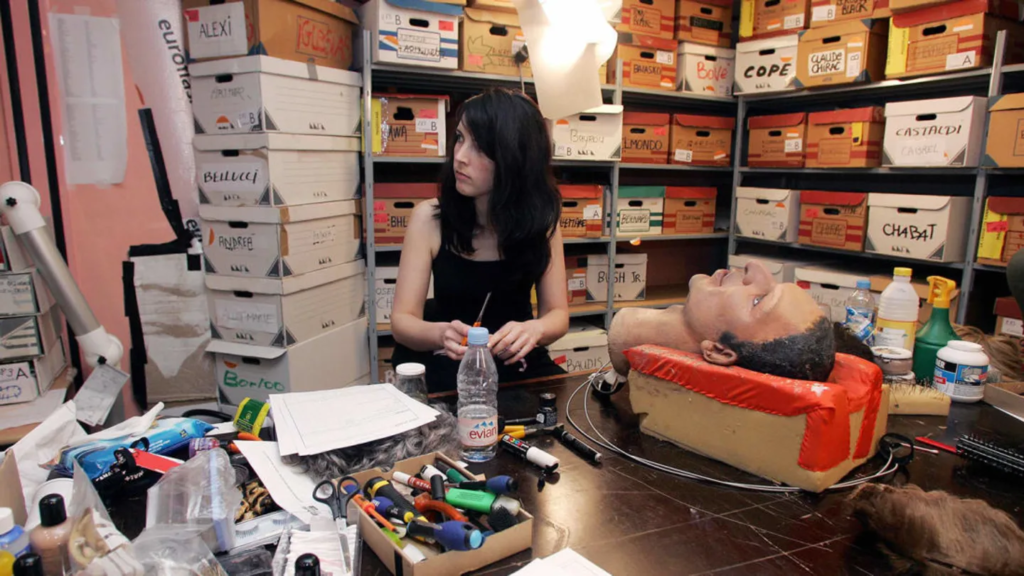Props Master (1 years diploma)
Props Master click here
Brief Job Description: Individuals in this job need to mark-up the script for set
props requirements. They need to procure these items, store them safely during
the shoot and ensure continuity.
Personal Attributes: This job requires the individual to purchase or produce any
props needed for a production. The individual should ideally have a background in
the interior design and a creative bent of mind. The individual must also know

available sources for hiring, purchasing or fabricating these items. The individual
must know how to manage items during the shoot and make them available based
on the script and continuity requirements. The individual must have strong
communication skills and must possess the ability to work collaboratively. The
individual must be flexible and able to make key decisions, keeping in mind the
impact on cost and timelines.
Qualifications Pack For Props Master
Definitions
Keywords /Terms Description
Blueprint A technical drawing of an architecture or engineering design, typically with
measurements and angles of each component
Budget Budget is an estimate of the total cost of production that may include a
break-up of cost components
Construction Schedule A detailed breakdown of activities for a construction project, with the
duration of each activity and organized in sequential order
Continuity Continuity represents the seamless transition from one shot to another
Copyright Laws A legal framework linked to intellectual property and the rights given to
creators of original products/ concepts
Draftsman (1) A visual artist who specializes in artistic drawings. Or, (2) A person who
prepares technical drawings and plans under the direction of an architect
or engineer or designer.
Dress Set Decorating the set for aesthetic/ visual purposes
Labour Laws Legal norms governing the relationship between workers, employers,
trade unions and the government
Post-production Post-production is the final finishing phase of the production, where the
raw footage is edited, special effects are added, music and sound are
integrated, colour correction is done etc.
Props A property, commonly shortened to prop (plural: props), is an object used
on stage or on screen by actors during a performance or screen production.
In practical terms, a prop is considered to be anything movable or portable
on a stage or a set.
Scale Drawings A drawing that depicts the accurate dimensions of an object, except they
have all been reduced or enlarged by a certain fixed percentage (called the
scale).
Screenplay Screenplay is the script coupled with key characteristics of the scene and
directions for acting

Script Script is a structured narrative of a story
Set The background/ scenery visible through the camera (for video production)
or directly to the spectator (for theatrical production)
Set Etiquette A set of guidelines that dictate how cast and crew should behave on set
and interact with each other
Strike Set Process of dismantling the set (including moveable items and
semipermanent fixtures), and storing, discarding or returning these items
Timelines Timelines is a listing of dates by which the production milestones/stages
need to be completed
Sector Sector is a conglomeration of different business operations having similar
businesses and interests. It may also be defined as a distinct subset of the
economy whose components share similar characteristics and interests.
Sub-sector Sub-sector is derived from a further breakdown based on the
characteristics and interests of its components.
Vertical Vertical may exist within a sub-sector representing different domain areas
or the client industries served by the industry
Qualifications Pack For Props Master
Occupation Occupation is a set of job roles, which perform similar/related set of
functions in an industry
Function Function is an activity necessary for achieving the key purpose of the
sector, occupation, or area of work, which can be carried out by a person
or a group of persons. Functions are identified through functional
analysis and form the basis of OS.
Sub-functions Sub-functions are sub-activities essential to fulfill the achieving the
objectives of the function.
Job role Job role defines a unique set of functions that together form a unique
employment opportunity in an organization
.
Occupational Standards
(OS)
OS specify the standards of performance an individual must achieve when
carrying out a function in the workplace, together with the knowledge and
understanding they need to meet that standard consistently. Occupational
Standards are applicable both in the Indian
and global contexts.
Performance Criteria Performance Criteria are statements that together specify the standard of
performance required when carrying out a task
National Occupational
Standards (NOS)
NOS are Occupational Standards which apply uniquely in the Indian
context.
Qualifications Pack
Code
Qualifications Pack Code is a unique reference code that identifies a
qualifications pack.
Qualifications Pack(QP) Qualifications Pack comprises the set of OS, together with the educational,
training and other criteria required to perform a job role. A Qualifications
Pack is assigned a unique qualification pack code.
Unit Code Unit Code is a unique identifier for an Occupational Standard, which Is
denoted by an ‘N’.
Unit Title Unit Title gives a clear overall statement about what the incumbent should
be able to do.

Description Description gives a short summary of the unit content. This would be
helpful to anyone searching on a database to verify that this is the
appropriate OS they are looking for.
Scope Scope is the set of statements specifying the range of variables that an
individual may have to deal with in carrying out the function which have
a critical impact on the quality of performance required.
Knowledge and Understanding
Knowledge and Understanding are statements which together specify the
technical, generic, professional and organizational specific knowledge that
an individual needs in order to perform to the required standard.
Organizational Context Organizational Context includes the way the organization is structured and
how it operates, including the extent of operative knowledge managers
have of their relevant areas of responsibility.
Technical Knowledge Technical Knowledge is the specific knowledge needed to accomplish
Specific designated responsibilities.
Core Skills/Generic
Skills
Core Skills or Generic Skills are a group of skills that are key to learning and
working in today’s world. These skills are typically needed in any work
environment. In the context of the OS, these include communication
related skills that are applicable to most job roles.
Keywords /Terms Description
CAD Computer Aided Design
NOS National Occupational Standard(s)
QP Qualifications Pack
NVEQF National Vocational Education Qualifications Framework
NVQF National Vocational Qualifications Framework
Wrap-up set and return/ dispose of items
Description This OS unit is about packing up items on set after the shoot is over (striking the set)
and ensuring items are returned or disposed of correctly
Scope This unit/task covers the following:
Packing-up various items and ensuring they are returned and disposed of correctly
Maintain documentation
Note:
This task can be undertaken by different members of the Set Crafts department,
depending on the scale and complexity of the project. Eg: On large projects, an Art
Director may participate in a supervisory capacity, while Set Decorators, Dressers,
Assistants etc. could be responsible for the physical return/disposal etc. of items.
Performance Criteria (PC) w.r.t. the Scope
Element Performance Criteria
Packing-up various
items and ensuring
they are returned and
disposed of correctly
To be competent, the user/individual on the job must be able to:
PC1. based on the script and production schedule prepare a schedule/to-do list of
key activities relating to pack-up/ striking the set, as appropriate to the role
PC2. supervise, or assist, support staff in striking the set, which may include:
Furniture
Soft furnishings
Wallpaper
Lighting fixtures
Decorative items
Hand props and featured props
Any other elements of the set that are not being struck by other teams
PC3. ensure, personally or in a supervisory capacity, that all set items are returned
or disposed of as planned
Maintain
documentation
PC4. ensure, personally or in a supervisory capacity, that necessary documentation,
records, refunds, payments etc. are maintained
Knowledge and Understanding (K)
A. Organizational
Context
(Knowledge of the
company /
organization and
its processes)
The user/individual on the job needs to know and understand:
KA1. The key expectations from the shoot, specifics of the location and any key
limitations on budget, resources and time availability
KA2. Relevant organizational processes for return of items, collecting security
refunds, disposal/ sale of items etc.
Wrap-up set and return/ dispose of items
B. Technical
Knowledge
The user/individual on the job needs to know and understand:
KB1. The requirement for different types of set furnishings and props and their
intended use

KB2. How to prepare a to-do-list/ schedule for striking the seat (based on the script
and production schedule)
KB3. How to determine whether items need to be (1) returned, (2) retained/ stored
for later, (3) disposed of/ discarded or (4) sold to other parties
KB4. How to ensure that any items required for continuity are correctly stored and
transported to the next set/ location
KB5. How to arrange for packing and moving staff to remove items from set and
transport them onward (to suppliers, disposal facilities, buyers etc.)
KB6. How to personally take down items and/ or supervise support staff in striking
the set
KB7. How to check the list of struck items against the original inventory list, and
account for items that are misplaced or damaged
KB8. How to correctly load and unload (or supervise loading and unloading) items to
ensure that items are not damaged
KB9. How to return, sell or dispose of items as planned, receive payments (e.g.
security deposit refunds, proceeds from sale) and submit documents and
payments to the Finance/ Production department
KB10. How to update the items list with details of return/ sale/ disposal and submit
this to the Finance/ Production department for closure
KB11. Applicable health and safety guidelines, and ensuring that the removal and
dismantling of set furnishings and props from the location minimizes any risks
to the individual’s own health and safety as well as those of the production
cast and crew
Skills (S)
A. Core Skills/
Generic Skills
Writing Skills
The user/ individual on the job needs to know and understand how to:
SA1. Prepare a
to-do list/ schedule for striking the set
SA2. Record details of return/ sale/ disposal against each item on the inventory list
Reading Skills
The user/individual on the job needs to know and understand how to: SA3. Read the
script, production schedule and item lists
SA4. Read receipts from vendors and buyers that take back set items to ensure that
the information captured is correct
Oral Communication (Listening and Speaking skills)
The user/individual on the job needs to know and understand how to:
SA5. Understand any constraints/ limitations that could affect the schedule for
striking the set (e.g. time, people, materials, budget)
SA6. Communicate effectively with the head of department, propose alternatives and
agree on key decisions
. Professional Skills Decision Making
The user/individual on the job needs to know and understand how to:
SB1. Make relevant decisions related to the area of work e.g. methods forremoval
and dismantling of items, choice of buyers etc.
Plan and Organize
The user/individual on the job needs to know and understand:
SB2. Plan his/her work according to the requirements and agreed timelines
SB3. Manage within the agreed budget and minimize overruns
Problem Solving
The user/individual on the job needs to know and understand how to:
SB4. Identify any problems with successful execution of the task
SB5. Communicate these to the head of department and identify solutions
Analytical Thinking
The user/individual on the job needs to know and understand how to:
SB6. Have a keen eye for detail and maintain an aesthetic sense towards the final
output
Critical Thinking

The user/individual on the job needs to know and understand how to:
SB7. re-use the set properties accordingly.
Customer Centricity
The user/individual on the job needs to know and understand how to:
SB8. Manage within the agreed budget and minimize overruns
Estimate Props Requirement
Description This OS unit is about understanding the script and creative vision and preparing a
comprehensive list of items required to furnish the set
Scope This unit/task covers the following:
Estimating prop requirements
Performance Criteria (PC) w.r.t. the Scope
Element Performance Criteria
Estimating prop
requirements
To be competent, the user/individual on the job must be able to:
PC1. understand the production brief and creative vision of the Director and
Producer, as appropriate
PC2. read the script and mark up the props requirement for each shot/ scene/
location, across the following types of items:
props/ Decorative items
hand props and featured props (i.e. props that are used by actors and/ or
form an integral part of the script)
PC3. identify prop requirements in line with the scope of the production’s budget
PC4. prepare a bill of quantities (list of items, price, delivery date) in orderto
procure all props
Knowledge and Understanding (K)
A. Organizational
Context
(Knowledge of the
company /
organization and
its processes)
The user/individual on the job needs to know and understand:
KA1. the expectations of the Director and Producer, any key limitations on budget,
resources and time availability
KA2. the key departments (e.g. Locations, Wardrobe, Finance) to be liaised with
and the role and contribution of these departments
B. Technical
Knowledge
The user/individual on the job needs to know and understand:
KB1. how to read and evaluate a script for props
KB2. how to mark up the script with the exact props requirement
KB3. how to translate the mark up into a comprehensive list of items with prices,
delivery dates and other key elements (bill of quantities)
KB4. how to estimate the appropriate quantity of perishable/ replaceable items to
ensure continuity (e.g. food items, beverages, cigarettes, flowers etc.)
KB5. applicable health and safety guidelines, and ensuring that the items selected
minimize any risks to the individual’s own health and safety as well as those of
the production cast and crew
Skills (S)
A. Core Skills/
Generic Skills
Writing Skills
The user/ individual on the job needs to know and understand how to:
SA1. mark up the script with the props requirements
SA2. prepare a comprehensive list of items and a bill of quantities
Reading Skills
The user/individual on the job needs to know and understand how to:
SA3. read and evaluate the script to determine the props requirements
Oral Communication (Listening and Speaking skills)
The user/individual on the job needs to know and understand how to:
SA4. understand the creative vision of the Director and Producer
SA5. understand any constraints/ limitations that could affect the procurement of
props (e.g. time, people, materials, budget)
B. Professional Skills Decision Making
The user/individual on the job needs to know and understand how to:
SB1. make relevant decisions related to the area of work e.g. choice of itemsto
achieve the desired look, whether items should be hired, purchased or
fabricated etc.
Plan and Organize
The user/individual on the job needs to know and understand:
SB2. plan his/her work according to the requirements and agreed timelines
SB3. manage within the agreed budget and minimize overruns
Problem Solving
The user/individual on the job needs to know and understand how to:
SB4. identify any problems with successful execution of the task
SB5. communicate these to the head of department and identify solutions
Critical Thinking
The user/individual on the job needs to know and understand how to:
SB6. guide/advise/discuss with production team as to where the equipment can be
supplied from
Customer Centricity
The user/individual on the job needs to know and understand how the:
SB7. identified requirements meets the technical and artistic requirements of
production and is available within budgetary and time constraints
SB8. appraise the items listed are in line with initial concept and quality standards
Analytical Thinking
The user/individual on the job needs to know and understand how to:
SB9. have a keen eye for detail and maintain an aesthetic sense towards the final
output
Procure props
Description This OS unit is about agreeing on the props requirement and procuring these items in
line with the production schedule
Scope This unit/task covers the following:
Determining suitable procurement methods
Procuring props
Performance Criteria (PC) w.r.t. the Scope
Element Performance Criteria
Determining suitable
procurement
methods
To be competent, the user/individual on the job must be able to:
PC1. identify and discuss cost-effective approaches to meeting the props requirement
PC2. determine the most appropriate method of procurement based on the item
required and its significance to the production, including:
hiring/ leasing/ renting
purchase
fabrication/ custom-making
Procuring props PC3. procure props – either through purchase, lease or fabrication, including the
following types of items:
props/ decorative items
hand props and featured props (i.e. props that are used by actors or
form an integral part of the script)
PC4. identify appropriate substitutes/ alternatives, if preferred items are not
available
Knowledge and Understanding (K)
A. Organizational
Context
(Knowledge of the
company /
organization and
its processes)
The user/individual on the job needs to know and understand:
KA1. the expectations of the Director and Producer, any key limitations on budget,
resources and time availability
KA2. key budgetary approval processes e.g. submission of bills for items procured
to the Finance department







